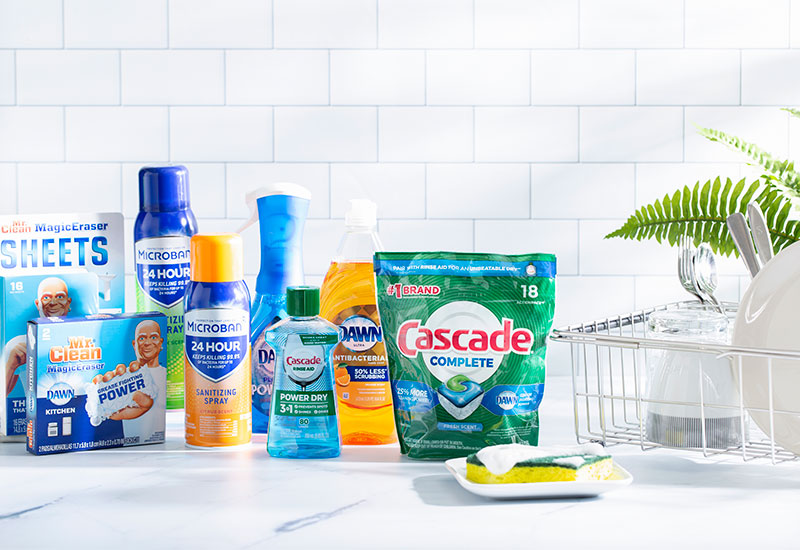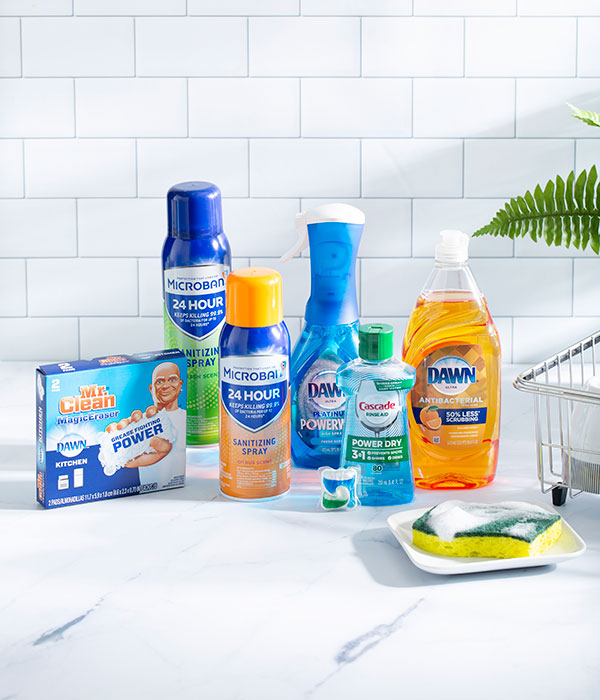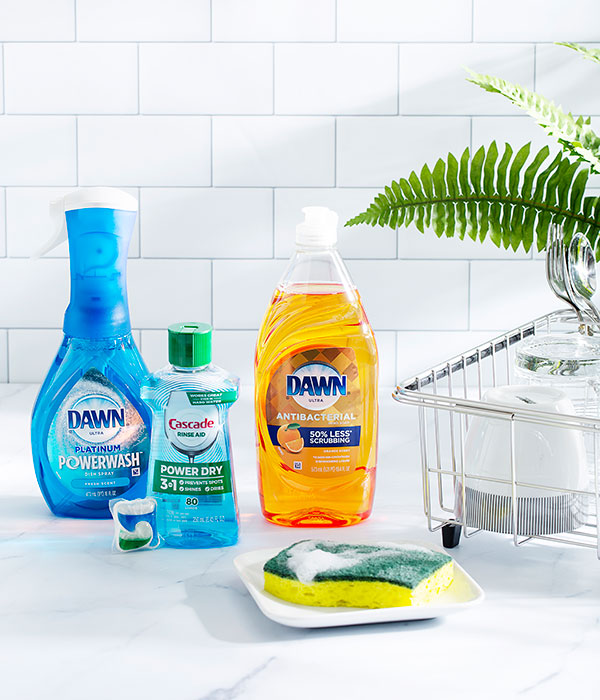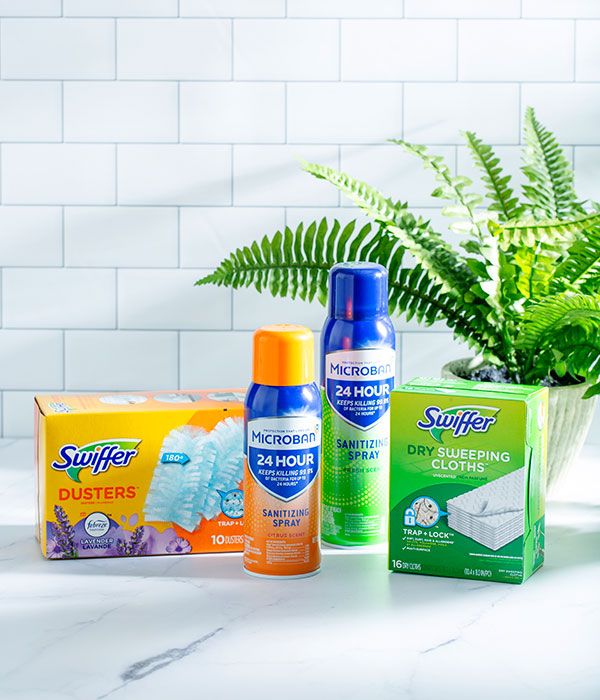12 Hacks to Lighten the Load of Dirty Dishes

This post is sponsored by Proctor & Gamble. All information was provided courtesy of local cookbook author and chef, Carla Snyder. Learn more about Carla at Ravenouskitchen.com.
There are few chores less appealing than washing dishes, but the reality of dirty dishes is that as long as there is eating and cooking, there will be dishes.
Someone has to do them, and even if you hate washing dishes with fire and passion, a sink of dirty dishes doesn’t have to signal the end of the world. Let’s throw everything but the kitchen sink (pun intended) at the dirty dish dilemma.
Read on for 12, count them 12, ways to make dishwashing more cheery and less dreary.
1.Whether washing in the sink or dishwasher, detergents have a big job to do. Liquid dish detergents do way more than clean crusty cookware, milky glasses and eggy forks. We can use a dish soap to spot clean carpets and hand wash delicate clothing as well as dishes, but when it comes to the dishwasher you have the option of powders, gels or tablets, all which work well. Powders are the most economical, single dose gel packs or tablets the most expensive (but easiest) and liquid gels fall somewhere in the middle. The trick is in finding the detergent that works best with the level of your water’s hardness. The biggest difference will be between brands and not the forms of the same brand. The Good Housekeeping Institute Cleaning Lab chose Dawn Platinum dishwashing liquid and Cascade Platinum ActionPacs dishwasher detergent as the best overall dishwashing detergent, along with Cascade Complete Gel + Oxi dishwasher detergent in gel form. That is a great place to start.
2. Scrape and rinse dishes immediately. It’s definitely easier to clean dishes that don’t have dried food cemented to them. Get in the habit of first scraping and then rinsing dishes before you place them in the sink to keep the process simple. However, it is not necessary to rinse dishes before placing them in the dishwasher. Just scrape and pop them in. To make the scraping even easier, I recommend using Dawn Powerwash. It loosens cooked-on food without water to reduce time scraping and rinsing.

3. Fill a dish pan or sink with hot, hot water. There are two common ways to hand wash dishes. One is to add dish soap to a sink or dishpan filled with hot water and the other is to squirt detergent directly onto a sponge or a dirty dish (called the “neat” method). Whichever method you prefer, be sure to follow product directions, as some detergents are concentrated and may require less soap than you think.
4. Use rubber gloves. Gloves will not only prevent “dishpan hands,” but allow you to hand wash dishes using really hot water. The hottest water melts stuck-on food more efficiently and speeds up the cleaning process, allowing you to get back to binge watching your latest Netflix series.
5. Speaking of hot water, run the faucet before starting a dishwasher load. If cold water is sitting in the pipes when you press “start,” your dishes will initially be washed with cold water, affecting cleaning performance. Run hot water from the nearest sink to purge the cold water from the line so that hot water enters the dishwasher at the beginning of the cycle.
6. Wash dishes in order of greasiness. Start with glassware and flatware, then plates and cups and end with the dirtiest and greasiest pans. Wipe out pans with paper towels to remove the worst grease and oil before washing, and don’t forget to wash the bottoms of the pans as well! You may have to drain and refill the sink if the water gets very dirty.
7. Watch out for sharp knives! Don’t pile sharp knives in the sink or dishwasher where you may accidentally grab them by the sharp edge. Wash sharp knives by hand, individually and lay them flat to dry. Washing sharp knives in the dishwasher can also dull the blades, plus you don’t want them rattling around banging against glasses and plates.
8. Invest in a good sponge. I like Mr. Clean Magic Erasers as I find that they really help break up hard-to-remove, burnt-on food from pots and pans. Some people also like the wands that fill with dish soap and have a brush or sponge on the end. Use what works for you. No judging. Oh, and remember that the dishwasher is a great place to store a sponge and give it a good wash every few days.
9. Load the dishwasher right. Ideally, there shouldn’t be a right or wrong way to load a dishwasher as long as someone is doing it. Right? But, there have been plenty of household disagreements over this simple but irksome task. The basics are:
- Don’t overload it.
- Load dishes along the back and sides so that they are facing the middle.
- Make sure the sprayer arm can move freely.
- Empty the bottom rack first so that any water collected in items on the top rack doesn’t drip down and wet dry dishes.
- Forks and knives are safest when placed tips down, but (sorry) they are cleaned more efficiently when tips are up.
10. Use a rinse aid. Most dishwasher detergents contain ingredients that help to ameliorate water spots, but using a separate rinse aid, such as Cascade Power Dry, will provide a better result. Because it’s dispensed directly into the rinse cycle where it’s most effective, it will also result in less gunk, film and buildup in your machine.

11. The tough stuff. Cooked-on food in pans is definitely the toughest to remove and for this job, a special tool is necessary. If you don’t already have one, a pan scraper made from food grade polycarbonate will rock your dish washing world. I fill pans with water as soon as the food exits them because I think that water going into a hot pan speeds the unsticking process. When dinner is over and the pan has cooled, give it a scrape with the scraper, dump the water down the drain and wash by hand with soapy water. For tougher jobs, use a powdered cleaner, such as Barkeepers Friend, for pots and pans or to shine up your stainless-steel sink like new.
12. Dry. Though air drying on a rack is easiest, drying with a lint-free towel allows you to remove water spots from glasses and flatware. To some, there’s nothing like a linen towel for drying dishes, but waffle weave microfiber towels are among the latest and greatest of dish towels. Whatever your dish towel of choice, make sure that it’s clean and once wet, left to air dry or be washed.
Washing dishes is a task most people do not look forward to, and while these hacks won’t save you from ever having to wash dishes, they are guaranteed to make the job a little more efficient. When combined with a can-do attitude, and maybe a little reward when finished, even the kiddos can help (popsicle anyone?). Think of it as training along with these tips and maybe one day they can take over the job completely, even without supervision. Dare to dream!
If you’re looking for items to keep your entire kitchen clean, not just the dishes, here are my go-to recommendations:
- Microban Sanitizing Spray
- Swiffer Wet and Dry Cloths and Dusters
- Mr. Clean Magic Erasers



